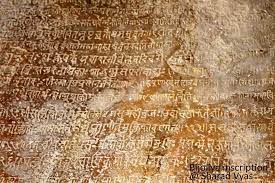Rajasthan ke pramukh shilaalekh in english (Major shilaalekh of Rajasthan)
Bijolia inscription -
Manmori inscription
- Manmori inscription was engraved on a pillar in Chittor near Mansarovar lake. The Manmori inscription dates back to the 8th century. Colonel James Todd drowned the Manmori inscription in the sea while on his way to England. According to Manmori inscription, Bhima is described as the king of Avantipur. The author of the Manmori inscription Pushya and the engraver Shivaditya are also mentioned in the Manmori inscription.
Inscription of Aparajit
- The inscription of Aparajit was inscribed on the wall of Kundeshwar temple near Nagda village of Udaipur district of Rajasthan in AD 661. The inscription of Aparajit gives information about the history of Mewar in the 7th century.
Goth Manglod inscription-
Inscription of Kumbhalgarh-
The inscription of Kumbhalgarh was engraved in 1460 AD in Kumbhalgarh fort of Rajsamand district of Rajasthan. The inscription of Kumbhalgarh is engraved on 5 rocks, these 5 rocks were installed in the Kumbhalgarh temple of Kumbhalgarh. Kumbhashyam Temple is presently called Mamadeva Temple. In the inscription of Kumbhalgarh, Bappa Rawal has been described as a Vipravanshi Brahmin. Dr. According to Gaurishankar Ojha, the author of the Kumbhalgarh inscription was the poet Mahesh. The inscriptions of Kumbhalgarh give information about the achievements of Maharana Kumbha. In the inscription of Kumbhalgarh, the victory of Kumbha, the route of the armies, construction work has also been mentioned. The inscription of Kumbhalgarh is an important means of knowing purely the genealogy of the Maharanas of Mewar.
Amber's inscription-
The inscription of Kanswa -
The inscription of Kanswa was engraved in 738 AD in the pagoda of Kanswa village near Kota, Rajasthan. Information about the Maurya rulers is found in the inscription of Kanaswa. It is known from only two inscriptions of Rajasthan that the Mauryas were related to Rajasthan such as Kanaswa's inscription (Kota), Pootholi's inscription (Chittor).
Ghosundi inscription-
Ghosundi inscription was engraved in Sanskrit language in Brahmi script in the village of Ghosundi near Nagari (Chittor) in Rajasthan in 200-150 BC. In the Ghosundi inscription, there is a mention of Sarvatta, the son of Parashari of Gajvansh of the second century BC, performing the Ashwamedha Yagya and building the boundary wall of the Vishnu temple. The first person to read the Ghosundi inscription was Dr. Dr. It was Bhandarkar. The Ghosundi inscription is the oldest inscription belonging to the Vaishnava (Bhagavata) sect in Rajasthan. The Ghosundi inscription is currently located in the Udaipur Museum of Rajasthan.
Nagari inscription -
The city inscription was engraved in Sanskrit language in Brahmi script at Nagari (Chittor) in Rajasthan in the 2nd century BC. Ghosundi inscription and Nagari inscription are also called twin inscriptions in Rajasthan. The inscription of the city is also presently located in the Udaipur Museum of Rajasthan.
Inscription of Cheerwa-
The inscription of Cheerwa was engraved on the outer gate of a temple in Chirwa village of Udaipur district of Rajasthan in 1273 AD. In the inscription of Cheerwa, information about the early rulers of Guhil dynasty (Bappa Rawal) is found. The practice of Sati has been mentioned in the inscription of Cheerwa. The inscriptions of Chirwa mainly reveal the political, cultural, religious and social condition of Rajasthan in the 13th century.
Kiradu's inscription-
Kiradu's inscription was engraved in Sanskrit language in 1161 AD in the Shiva temple of Kiradu (Barmer), Rajasthan. In the article of Kiradu, the origin of the Paramaras is told from the Abu Yagya of Rishi Vashistha.
Articles of Jain Kirti Stambh -
The articles of Jain Kirti Stambh were engraved in 13th century in Jain Kirti Stambh of Chittor, Rajasthan. The founder of the three inscriptions engraved in the Kirti Stambh was the brother-in-law.
Ghatiala inscription-
Ghatiyala inscription was engraved in 861 AD in Ghatiyala (Jodhpur) of Rajasthan. The Ghatiala inscription mentions the Pratihara ruler Kakkuk. According to Ghatiyala inscription, Harishchandra was the Adi Purush of the Gurjara Pratiharas and the Gurjara Pratiharas established their rule in Mandore.
Shringi Rishi's inscription-
Shringi Rishi's inscription was engraved on black stone in Sanskrit language in 1428 AD. This article is attached in the verandah at a place called Shringi Rishi near Eklingji in Udaipur, Rajasthan. In this article information about the caves of Mewar is found. This article is from the time of Maharana Mokal.
Bairath Nagar inscription-
Bairath Nagar inscription was obtained from Jaipur in Rajasthan. This inscription dates back to the time of the Mauryan emperor Ashoka.The work of writing the first inscription in India was started by the Maurya Emperor Ashoka.
Commendation of Neminath (Abu) Temple-
The commendation of Neminath temple was engraved by Tejpal in 1230 AD in Delwara village (Dilwara village) of Mount Abu, Rajasthan. The Neminath Temple Prashasti gives information about the Paramara Vesiya rulers. The description of Dharavarsha, the ruler of Abu, is also found in the Neminath Prashasti. Neminath Prashasti is also known as Lunavasahee Prashasti.
Raisingh Prashasti-
Raisingh Prashasti was engraved in Sanskrit language in Bikaner fort of Rajasthan in 1594 AD by the ruler of Bikaner, Rai Singh. The Raisingh Prashasti gives information about the Rathore rulers from Rao Bika to Raisingh. The author of Raisingh Prashasti was a Jain monk named Jaita. Raisingh Prashasti describes the victories of Raisingh and his love for literature. According to Raisingh Prashasti, Bikaner fort (Junagarh or Lalgarh) was built by Raisingh under the supervision of his minister Karmachandra. Rai Singh Prashasti is also known as Bikaner Fort Prashasti and Junagadh Prashasti.




Comments
Post a Comment